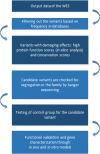Whole-exome sequencing and its impact in hereditary hearing loss
- PMID: 25825321
- PMCID: PMC5503681
- DOI: 10.1017/S001667231500004X
Whole-exome sequencing and its impact in hereditary hearing loss
Abstract
Next-generation sequencing (NGS) technologies have played a central role in the genetic revolution. These technologies, especially whole-exome sequencing, have become the primary tool of geneticists to identify the causative DNA variants in Mendelian disorders, including hereditary deafness. Current research estimates that 1% of all human genes have a function in hearing. To date, mutations in over 80 genes have been reported to cause nonsyndromic hearing loss (NSHL). Strikingly, more than a quarter of all known genes related to NSHL were discovered in the past 5 years via NGS technologies. In this article, we review recent developments in the usage of NGS for hereditary deafness, with an emphasis on whole-exome sequencing.
Figures
References
-
- Bamshad M. J., Ng S. B., Bigham A. W., Tabor H. K., Emond M. J., Nickerson D. A. & Shendure J. (2011). Exome sequencing as a tool for Mendelian disease gene discovery. Nature Reviews Genetics 12, 745–755. - PubMed
-
- Behlouli A., Bonnet C., Abdi S., Bouaita A., Lelli A., Hardelin J. P., Schietroma C., Rous Y., Louha M., Cheknane A., Lebdi H., Boudjelida K., Makrelouf M., Zenati A. & Petit C. (2014). EPS8, encoding an actin-binding protein of cochlear hair cell stereocilia, is a new causal gene for autosomal recessive profound deafness. Orphanet Journal of Rare Disease 9, 55. - PMC - PubMed
-
- Brownstein Z., Friedman L. M., Shahin H., Oron-Karni V., Kol N., Abu Rayyan A., Parzefall T., Lev D., Shalev S., Frydman M., Davidov B., Shohat M., Rahile M., Lieberman S., Levy-Lahad E., Lee M. K., Shomron N., King M. C., Walsh T., Kanaan M. & Avraham K. B. (2011). Targeted genomic capture and massively parallel sequencing to identify genes for hereditary hearing loss in Middle Eastern families. Genome Biology 12, R89. - PMC - PubMed
Publication types
MeSH terms
Supplementary concepts
Grants and funding
LinkOut - more resources
Full Text Sources
Miscellaneous


